EPA 8270 Semivolatile Organic Compounds by GC MS
The EPA Method 8270D is a widely recognized standard used to analyze semivolatile organic compounds (SVOCs) in environmental samples. This method employs gas chromatography-mass spectrometry (GC-MS) for the identification and quantification of these compounds, which are often present at low concentrations and have boiling points ranging from 250°C to 600°C.
The primary objective of this testing is to ensure that materials and products comply with environmental regulations. SVOCs can be found in various consumer goods, industrial processes, and environmental samples, making their analysis critical for regulatory compliance and product safety. This method is particularly useful for detecting contaminants in air, water, soil, and solid waste.
The testing process involves several key steps: sample preparation, extraction of the SVOCs, derivatization to enhance detection, and injection into the GC-MS system. The GC separates the compounds based on their volatility and polarity, while the MS identifies them by measuring molecular ions. This combination provides precise and reliable results.
The method is stringent and includes detailed sample preparation protocols as specified in the EPA 8270D documentation. It ensures that all SVOCs are captured for analysis without degradation or contamination. The use of GC-MS allows for high sensitivity, allowing even trace amounts of compounds to be detected.
The test results are reported with quantification limits and identification criteria as per the EPA standards. This information is crucial for regulatory compliance and can inform product development and manufacturing processes.
Why Choose This Test
Selecting the EPA 8270D test for analyzing semivolatile organic compounds offers several advantages:
- Regulatory Compliance: Ensures adherence to environmental regulations and standards.
- Precision: High sensitivity allows for accurate quantification of even trace amounts of SVOCs.
- Comprehensive Analysis: Captures a wide range of compounds, providing comprehensive data.
- Scientific Rigor: The method is validated and standardized by the EPA, ensuring reliability.
The test is particularly useful for industries dealing with hazardous materials or those subject to stringent environmental regulations. Quality managers can use this information to ensure that their products meet all necessary standards, while compliance officers have a reliable tool for monitoring and reporting on SVOC levels in various samples.
Quality and Reliability Assurance
Our laboratory adheres to strict quality management practices to ensure the accuracy and reliability of our EPA 8270D testing. We follow all procedures as outlined in the official EPA Method 8270D documentation, ensuring that every step from sample preparation to final analysis is meticulously controlled.
We use state-of-the-art GC-MS instrumentation, regularly calibrated and maintained by certified technicians. This ensures that our equipment is always operating at peak performance levels. Our team of experts is trained in the latest techniques for SVOC testing, providing reliable results every time.
Our quality assurance processes include regular internal audits and external certifications to ISO/IEC 17025 standards. These processes ensure that we meet the highest industry standards and provide clients with confidence in our test results. Compliance officers can trust us to deliver accurate and timely reports, which are essential for maintaining regulatory compliance.
Use Cases and Application Examples
| Sample Type | Purpose of Testing | Expected Outcomes |
|---|---|---|
| Air Samples | Detect SVOCs from industrial processes or accidental releases. | Identify specific compounds and quantify their presence in the air. |
| Water Samples | Evaluate water quality for compliance with environmental regulations. | Determine if SVOC levels are within acceptable limits set by regulatory bodies. |
| Solid Waste | Assess the content of SVOCs in waste materials for proper disposal or recycling. | Ensure that waste materials meet all relevant standards and can be processed safely. |
| Consumer Products | Determine compliance with SVOC content limits set by consumer safety regulations. | Ensure products are safe for use, protecting both the environment and consumers. |
- Air Samples: Useful in identifying volatile organic compounds (VOCs) that may be precursors to SVOCs, aiding in air quality management.
- Water Samples: Essential for ensuring compliance with drinking water standards and assessing potential sources of contamination.
- Solid Waste: Helps in understanding the environmental impact of waste materials and guiding disposal practices.
- Consumer Products: Crucial for product safety, especially when dealing with chemical-laden products like cleaning agents or paints.
The results from these tests can inform various stakeholders, from regulatory bodies to manufacturers, on the presence and concentration of SVOCs in different environments. This information is vital for making informed decisions about product development, environmental impact assessment, and compliance strategies.





